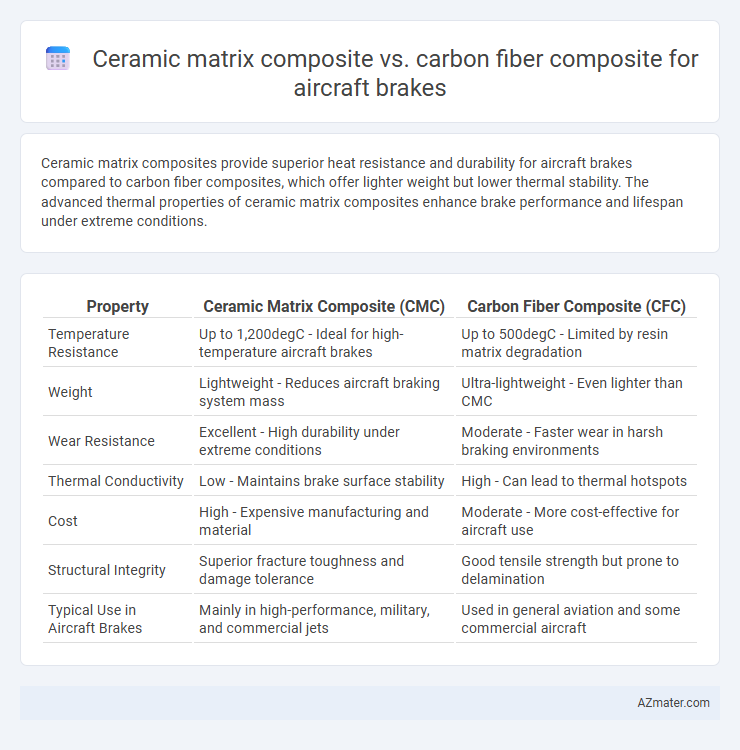Ceramic matrix composites provide superior heat resistance and durability for aircraft brakes compared to carbon fiber composites, which offer lighter weight but lower thermal stability. The advanced thermal properties of ceramic matrix composites enhance brake performance and lifespan under extreme conditions.
Table of Comparison
| Property | Ceramic Matrix Composite (CMC) | Carbon Fiber Composite (CFC) |
|---|---|---|
| Temperature Resistance | Up to 1,200degC - Ideal for high-temperature aircraft brakes | Up to 500degC - Limited by resin matrix degradation |
| Weight | Lightweight - Reduces aircraft braking system mass | Ultra-lightweight - Even lighter than CMC |
| Wear Resistance | Excellent - High durability under extreme conditions | Moderate - Faster wear in harsh braking environments |
| Thermal Conductivity | Low - Maintains brake surface stability | High - Can lead to thermal hotspots |
| Cost | High - Expensive manufacturing and material | Moderate - More cost-effective for aircraft use |
| Structural Integrity | Superior fracture toughness and damage tolerance | Good tensile strength but prone to delamination |
| Typical Use in Aircraft Brakes | Mainly in high-performance, military, and commercial jets | Used in general aviation and some commercial aircraft |
Introduction to Advanced Aircraft Brake Materials
Ceramic matrix composites (CMCs) and carbon fiber composites (CFCs) represent advanced materials revolutionizing aircraft brake systems with their high strength-to-weight ratios and exceptional thermal resistance. CMCs offer superior heat tolerance above 1,200degC, reducing thermal degradation during intense braking, while CFCs provide lightweight stiffness and fatigue resistance essential for repeated high-stress cycles. Both materials enhance brake performance by improving wear resistance, lowering weight, and increasing durability, critical for modern aerospace safety and efficiency standards.
Overview of Ceramic Matrix Composites (CMCs)
Ceramic Matrix Composites (CMCs) for aircraft brakes offer superior thermal stability and wear resistance compared to traditional materials, enabling them to withstand extremely high temperatures up to 1,500degC. These composites combine ceramic fibers, such as silicon carbide, with a ceramic matrix, resulting in enhanced fracture toughness and reduced weight. Their ability to maintain structural integrity under thermal shock makes CMCs ideal for high-performance, lightweight braking systems in advanced aircraft.
Overview of Carbon Fiber Composites
Carbon fiber composites consist of carbon fibers embedded in a polymer matrix, offering high strength-to-weight ratio and excellent fatigue resistance crucial for aircraft brake systems. These composites provide superior impact resistance and thermal conductivity, enhancing brake performance and durability under extreme operating temperatures. Their lightweight nature contributes to overall aircraft weight reduction, improving fuel efficiency without compromising braking reliability.
Key Material Properties Comparison
Ceramic matrix composites (CMCs) exhibit superior thermal resistance and high-temperature stability compared to carbon fiber composites, making them ideal for aircraft brake applications subjected to extreme heat. CMCs offer excellent oxidation resistance and maintain structural integrity at temperatures above 1200degC, whereas carbon fiber composites generally degrade above 400degC. Despite carbon fiber composites providing higher tensile strength-to-weight ratios, the wear resistance and thermal conductivity of CMCs result in longer brake lifespan and enhanced performance during repeated high-temperature braking cycles.
Thermal Performance in Aircraft Braking Systems
Ceramic matrix composites (CMCs) offer superior thermal resistance and stability at temperatures exceeding 1,200degC, making them ideal for aircraft brake components subjected to extreme heat during high-speed deceleration. Carbon fiber composites (CFCs), while lightweight and strong, typically experience degradation above 600degC, limiting their thermal performance in braking systems. The enhanced thermal conductivity and oxidation resistance of CMCs translate to improved heat dissipation and longer brake life, critical for reliable aircraft operation under harsh thermal cycling.
Wear Resistance and Durability
Ceramic matrix composites (CMCs) exhibit superior wear resistance and durability compared to carbon fiber composites (CFCs) in aircraft brake applications, primarily due to their ability to withstand high temperatures and resist oxidation. CMCs maintain structural integrity and performance under thermal cycling and mechanical stress, extending brake lifespan and reducing maintenance frequency. In contrast, carbon fiber composites, while lightweight and strong, have lower thermal stability and are more prone to wear and degradation in extreme braking conditions.
Weight and Fuel Efficiency Implications
Ceramic matrix composites (CMCs) used in aircraft brakes offer significant weight reductions compared to traditional carbon fiber composites, enhancing overall fuel efficiency by lowering the aircraft's mass. CMCs exhibit superior thermal resistance and maintain structural integrity under extreme braking conditions, which reduces maintenance frequency and associated operational costs. The lower density and high-performance characteristics of CMC brake components directly contribute to decreased fuel consumption and improved aircraft range.
Maintenance and Life Cycle Costs
Ceramic matrix composites (CMCs) offer superior heat resistance and longer lifespan compared to carbon fiber composites, reducing maintenance frequency and overall life cycle costs for aircraft brake systems. Carbon fiber composites, while lightweight and strong, typically require more frequent inspections and replacements due to lower temperature tolerance and wear resistance. The higher initial cost of CMCs is offset by reduced downtime and fewer part replacements, making them more cost-effective over the aircraft's operational lifespan.
Recent Innovations and Industry Adoption
Recent innovations in ceramic matrix composites (CMCs) for aircraft brakes emphasize enhanced thermal resistance and reduced weight compared to traditional carbon fiber composites, enabling superior high-temperature performance and longer service life. Industry adoption is accelerating as leading aerospace manufacturers integrate CMCs to improve brake efficiency and reduce maintenance costs, driven by advancements in manufacturing techniques such as additive manufacturing and improved fiber-matrix bonding. While carbon fiber composites remain widely used due to established supply chains and cost-effectiveness, the growing preference for CMCs highlights a shift towards materials offering greater reliability under extreme conditions.
Conclusion: Choosing the Right Composite for Aircraft Brakes
Ceramic matrix composites (CMCs) offer superior heat resistance and thermal stability compared to carbon fiber composites, making them ideal for high-temperature aircraft brake applications. Carbon fiber composites provide excellent strength-to-weight ratio and impact resistance but may suffer from oxidation and reduced performance at elevated temperatures. Selecting the right composite depends on mission-specific requirements, balancing thermal durability, weight considerations, and cost-effectiveness for optimal aircraft brake performance.

Infographic: Ceramic matrix composite vs Carbon fiber composite for Aircraft brake
 azmater.com
azmater.com